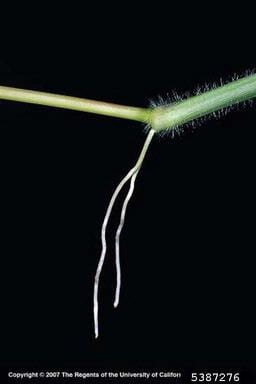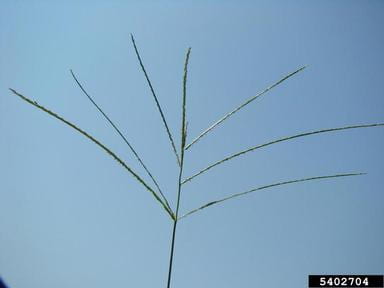There are two species of crabgrass that are problematic in NYS. Smooth crabgrass (Digitaria ischaemum) is a summer annual and found in many habitats, such as small fruits (berries) crops in NYS, as well as other landscapes. It is present across the U.S., but is less common than its relative, large crabgrass. Large crabgrass (Digitaria sanguinalis) is a summer annual and has a wide range of habitats (such as agronomic and landscape) that match its distribution across the U.S. It is mainly found in field crops, vegetable, and berry systems in NYS. Both species will grow in poor soil.
Similar species
Table 3: Compares smooth and large crabgrasses (Digitaria ischaemum and D. sanguinalis) and southern crabgrasses (D. ciliaris).
| Species | Smooth crabgrass (Digitalis ischaemum) | Large crabgrass (Digitaria sanguinalis) | Southern crabgrass (Digitaria ciliaris) | ||
|---|---|---|---|---|---|
| Similarities | Leaf bud rolled; ligule membranous; no auricles | Leaf bud rolled; ligule membranous; no auricles | Leaf bud rolled; ligule membranous; no auricles | ||
| Differences | Sometimes hairy on the blade near the base and occasionally hairy near the collar region on the sheath; smaller than large crabgrass | Has a hairy blade and the sheath has stiff perpendicular hairs; larger than smooth crabgrass | Hairs on sheath, none on blade; more common in the southeast U.S. |
Smooth crabgrass
Scientific name: Digitaria ischaemum
Identification
Mature plant: The sheath can have hairs that usually appear around the collar region. The root system is fibrous.
Height: 23.6 in (60 cm)
Flowers/fruit: Forms three to five spikes in a cluster.
Spike length: 3.9 in (10 cm)
Spikelet size: 0.03-0.04 in (0.8-0.9 mm) wide by 0.07-0.08 in (1.8-2.1 mm) long
Management
Chemical control
There are multiple pre-emergent and post-emergent tactics for controlling smooth crabgrass. Some active ingredients for pre-emergent include, benefin and oryzalin (group 3), terbacil (group 5), as well as other chemicals and groups. For post-emergent clethodim (group 1), diuron (group 7), and several others. For more information use CCE Eastern NY Horticulture’s herbicide lookup tool to find the efficacy of various herbicides on smooth crabgrass. For general guidance on weed control, get the latest edition of the Cornell Crop and Pest Management Guidelines.
Pre- and post-emergence control
Pre-emergent:
Group 3
Benefin and oryzalin
DCPA*
Pendimethalin*
Pronamide
Group 5
Terbacil
Hexazinone
Group 7
Diuron
Group 12
Norflurazon
Group 14
Flumioxazin
Group 15
Napropamide
S-metolachlor
Group 20
Dichlobenil
Post-emergent:
Group 1
Clethodim
Fluazifop-p-butyl
Sethoxydim
Group 7
Diuron
Group 9
Glyphosate
Group 10
Glufosinate ammonium
Group 14
Flumioxazin**
Group 22
Paraquat
Group 27
Pelargonic acid
* Specifically used in strawberry systems, ** used in blueberries.
Non-chemical control
For winter wheat systems, crop rotation with spring crops is useful. Seedbed prep for spring crop will destroy previous year’s seedlings (behaves like a winter annual). A delay in planting fall crops gives time for the grass to germinate, which permits the destruction of seedlings during bed prep. When dryland crop rotations are used with summer fallowing, after harvesting wheat cultivation should take place, or this should occur in early spring to prevent seed production. Plowing under current seed is effective. For new pastures cheat grass should be reduced in order to manage soil water levels. For established pastures, keep grazing uniform (less than 24 inches (60 cm). Fire and overgrazing are linked with an onslaught of B. secalinus.
Large crabgrass
Scientific name: Digitaria sanguinalis
Other names: northern crabgrass, hairy crabgrass
Identification
Seedlings: The leaf bud is rolled, and the leaf blade is linear.
Leaf blade size: 2-4.75 inches (5.1-12.1 cm) long by 0.1-0.2 inches (0.25-0.51 cm)
Leaf blade shape: lanceolate to linear
Large crabgrass stem featuring sideview of ligule, auricle, and collar region.
Photo by Joseph M. DiTomaso of University of California–Davis, via Bugwood.org

Large crabgrass rooting at node with adventitious roots.
Photo by Joseph M. DiTomaso of University of California–Davis, via Bugwood.org
Management
Chemical
Visit Cornell’s Turfgrass and Landscape Weed ID for more information on chemical control. Also, use CCE Eastern NY Horticulture’s herbicide lookup tool to find the efficacy of various herbicides on large crabgrass. For general guidance on weed control, get the latest edition of the Cornell Crop and Pest Management Guidelines.
Non-chemical control
Cultural
Since seed dispersal is its primary mode of reproduction, any method that prevents seed development will drastically decrease the spread of crabgrass. In a turfgrass system, mowing height will impact this weed. In agricultural or horticultural settings mulching, hoeing, and manual pulling will help with the management of crabgrass. Cultivators can be used, however, they should cut flat and shallow in order to dry the shoots on the soil surface. In vegetable rotations (with early, short season crops) seedlings emerge right before harvest. When the soil is cool, a straw mulch in spring keeps soil too cold to promote germination and is highly efficient. Once soil warms, this method will be counter-productive.
Herbicide resistance
Reported as of 2021:
Smooth crabgrass
North America
U.S.
Group 1 (1 state)
Group 4 (1 state)
Other continents
None
Large crabgrass
North America
U.S.
Group 1 (2 state)
Canada
Group 1 (Ontario)
Other continents
Asia
Group 1
Australia
2-way multiple resistance to groups 1 and 2 (Australia)
Europe
Groups 1, 2, 5
For a more detailed report, please visit the reference section below or visit the International Herbicide-Resistant Weed Database homepage for more information on resistance.
References
For more smooth crabgrass information with specific Turfgrass control check out Purdue University Turfgrass Science.
For information on large crabgrass identification, check out University of California IPM Program.
For specific information to New York State, consider the New York Flora Atlas.
The University of California IPM Program has a page on crabgrass generally with management.
For IPM tactics to reduce smooth or large crabgrass look at the Northeastern IPM Center page.
For more information please look for the upcoming book, Manage Weeds on Your Farm: A Guide to Ecological Strategiesby Charles L. Mohler, John Teasdale, and Antonio DiTommaso (Publisher: SARE Outreach, expected late fall of 2021).
Uva R H, Neal J C, DiTomaso J M. 1997. Weeds of the Northeast. Book published by Cornell University, Ithaca NY. The go-to for weed ID in the Northeast; look for a new edition sometime in 2019.
Use this tool to look up the efficacy of herbicides on a particular weed species. For general guidance on weed control, get the latest edition of the Cornell Crop and Pest Management Guidelines. For specific information on small fruit crop systems consider the Berry Crop Guidelines.
Images included from Invasive.org. Offers an extensive online library of images for invasive and exotic species of North America.
Images also included from wikimedia.org.
Herbicide resistance details (2021)
Smooth crabgrass
North America
U.S.
Mid-atlantic: New Jersey, group 1 (fenoxaprop-ethyl)
West: California, group 4 (quinclorac)
Other continents
None
Large crabgrass
North America
U.S.
Midwest: Wisconsin, group 1 (fluazifop-butyl, sethoxydim)
South East: Georgia, group 1 (sethoxydim)
Canada
Province of Ontario: group 1 (clethodim, fenoxaprop-ethyl, fluazifop-butyl, quizalofop-ethyl, and sethoxydim)
Other continents
Asia
China, group 1 (quizalofop-ethyl) and group 2 (nicosulfuron)
Australia
Australia, multiple resistance to groups 1 and 2 (fluazifop-butyl, haloxyfop-methyl, and imazethapyr)
Europe
Poland, group 5 (atrazine); Italy, group 1 (cycloxydim, and fluazifop-butyl); France, groups 1 (cycloxydim, fluazifop-butyl, haloxyfop-methyl, and quizalofop-ethyl) and 2 (foramsulfuron, and nicosulfuron); Czech Republic, group 5 (atrazine)










